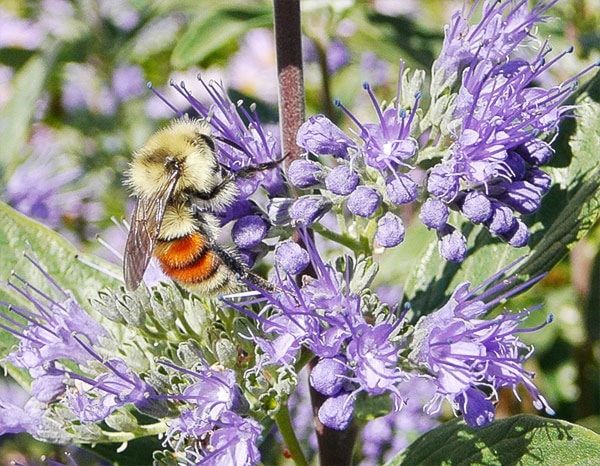Fall is officially here and we are experiencing lovely sunny days without the intense heat of summer.
Gardens are a delight of vibrant colours and activity.
Flocks of songbirds are feasting on seeds, especially the forest of sunflowers that self-seeded in my side yard and have thrived, in sand, with almost no water.
There’s a fascinating variety and abundance of honeybees, bumblebees and other pollinators busy getting in final ‘supplies’ on every warm, sunny day.
Plants they seem most interested in are asters, Sedum ‘Autumn Joy’, lavender, Nepeta ‘Walkers Low’ (catnip) and beautiful, white garlic chive blooms.
Two late blooming shrubs hum with activity.
Caryopteris (bluebeard or blue mist) is covered in vibrant, blue flowers in August and September. At a compact three to five feet high and wide, it’s a fantastic addition to the sunny garden.
The sulphur yellow flowers of our very garden-worthy, native shrub, rabbitbrush (Ericameria nauseosa) are full of bees.
Bees are essential in the pollination of many of our food crops. Can you imagine having to live without tree fruits and berries that are so bountiful here?
There is a world-wide collapse in bee colonies, likely a result of pesticide use. This endangers our food supply, raising awareness of the problem.
Our community is experiencing a huge upsurge in people learning to grow their own produce.
These new gardeners are on a quest to learn how to increase their production and grow the healthiest of food.
Pollinators are of vital importance. A garden hive of honey-bees is a sure way to have maximum pollination for high yields. Mini hives are appearing in many back yard gardens, benefiting all who live close by.
The Public Art Pollinator Pasture is an exciting new project created through the Eco-Art Incubator at UBCO.
The dream and goal of UBCO professor Nancy Holmes is to make a garden, friendly to native bees and to make it as water-wise and ecologically-healthy as possible.
Collaborators include students and people interested in plants, agriculture, ecology and water issues in the Okanagan.
The city donated land at the historic Brent’s Grist Mill Heritage Site for this public art-driven wild flower meadow that will benefit many essential pollinators (including bees, butterflies and birds) and will empower communities to be ecological ambassadors and citizen scientists.
Last Sunday, there was a large-scale model of a mason bee tube on display and the community was invited to make their own take-away mason bee houses at the Grist Mill site, corner of Leckie and Dilworth in Kelowna.
Ecological artist Lori Mairs also guided participants in building on-site mini-homes for native bees out of recycled materials.
